1997 Aston Martin DB7 3.2 Auto vs 1997 BMW 840Ci Auto 4.4 E31
Which do we prefer out of this still popular pair of Nineties coupes – the traditional Aston Martin DB7 Coupe or the more modern BMW 840Ci E31? There’s only one way for us to find out…
WORDS & PHOTOGRAPHY PAUL WALTON
DIFFERENT STROKES DB7 vs BMW 840Ci
We pitch our 1997 DB7 3.2 against a 1997 BMW 840Ci E31 in this battle of the Nineties coupes
As two-door, four-seat coupes that arrived at roughly the same time in the mid- Nineties, the Aston Martin DB7 and BMW 840Ci E31 have, on paper at least, much in common. But with one exhibiting futuristic styling and powered by a modern V8, while the other being more traditional-looking, that’s also based on a much older car that has origins with another manufacturer, they have more differences than they do similarities.
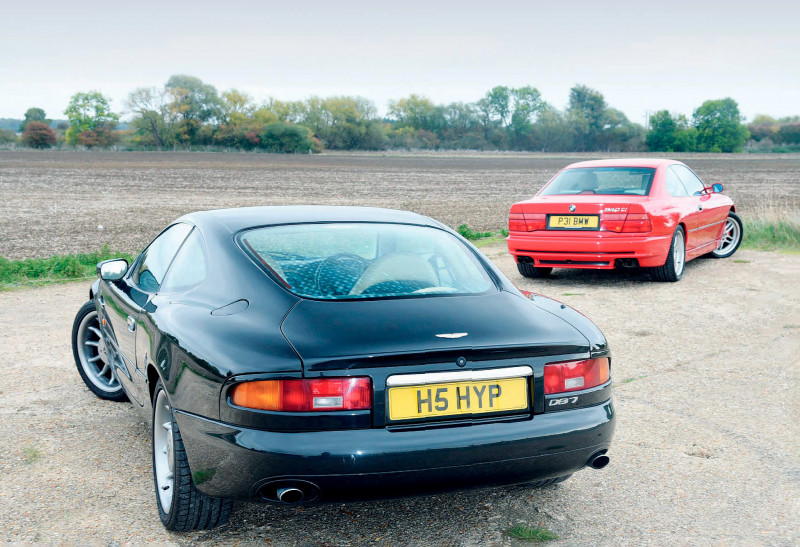
To discover which we prefer out of innovation or convention, we’re comparing a 1997 example of both.
1997 BMW 840Ci Auto 4.4 E31
Despite arguably looking and feeling more modern than the Aston Martin DB7, the BMW arrived first, debuting at the 1989 Frankfurt Motor Show before going on sale the following year. By being more powerful and more expensive, it wasn’t a direct replacement for BMW’s previous coupe, the E24 6-Series.
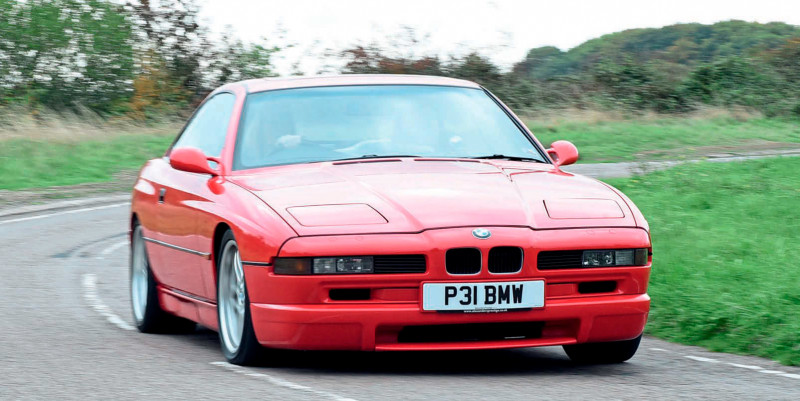
Often viewed as too big, too complicated and too expensive, the BMW E31 8-Series was never as popular as its huge investment warranted
The idea of such a model was originally considered by BMW in 1981 with the green light for the car – internally known as the E31 – given five years later. The work of in-house designer, Klaus Kapitza, it featured a much more angular and chiselled design than the softer 6-Series. Plus, by being based on the E32-generation of the 7-Series, it was longer and wider than its predecessor. The press wasn’t always impressed by the new look, though. “It’s an old-school, square cut BMW,” said Car magazine in its November 1996 issue, “elegant but too discreet to be exciting.”
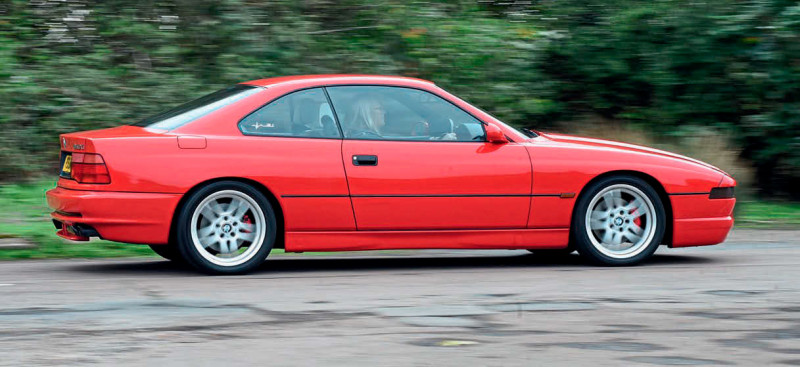
What really set the E31 apart from the 6-Series (or the competition for that matter) was the abundance of clever technology, much of it not seen before. This included an electronic drive-by-wire throttle, four-wheel steering and intelligent automatic transmission. Little wonder BMW managed to spend a huge $900 million on the car’s development. Yet this eye-watering amount didn’t include a convertible version and other than a handful of expensive aftermarket conversions, the 8-Series was only ever available as a coupe. To begin with, the only engine choice was BMW’s first production V12, a 5.0-litre that delivered 300bhp resulting in a 0-60mph time of seven seconds. This decadent engine together with all that tech made the 850i E31 an expensive choice. At £61,495 in 1992, it cost £13,500 more than its nearest V12-engined rival, the 6.0-litre XJR-S.
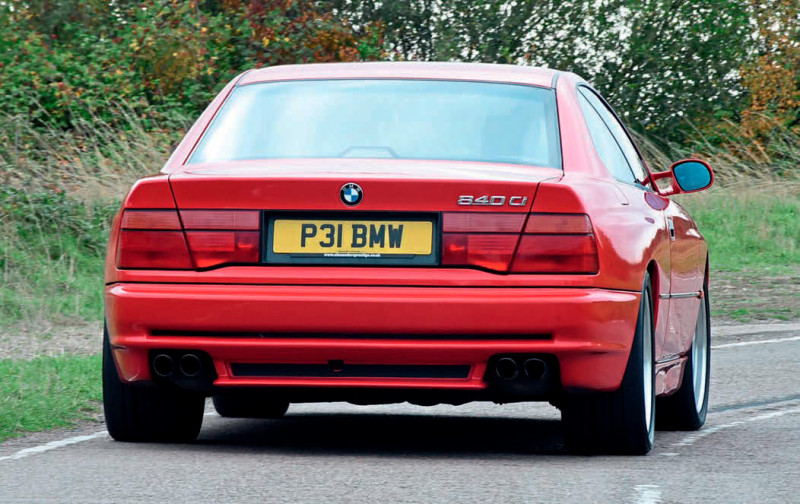
Yet the critics were never that impressed by the car, feeling that it lacked character. “You would always respect such country-crossing abilities,” said Car magazine in its October 1992 issue, “but never fall passionately in love with it as a loyal and faithful servant. Somehow the E31 BMW 850i is a shade too nice, too pinkly soft, too twee: it tries a mite hard to be friendly and accommodating, offers heart but not soul.”
A slightly more affordable option, a 4.0-litre V8, arrived in mid-1993 but at £52,950, was still £20k more than the recently updated XJS 4.0. Two years later the capacity was increased to 4.4 litres M62B44TU which didn’t change the power output of 286bhp but the torque was increased from 295Ib ft to 310lb ft. Often viewed as too big, too complicated and too expensive, the 8-Series was never as popular as its huge investment warranted. Admittedly the global recession of the early Nineties hit sales hard, the all-important American market especially, but between 1990 and 1999 a mere 30,621 examples were produced. Of those, just 7,803 were the V8-powered 840Ci making the red 1997 example I’ve arranged to drive a real rarity and one I’m excited to experience.
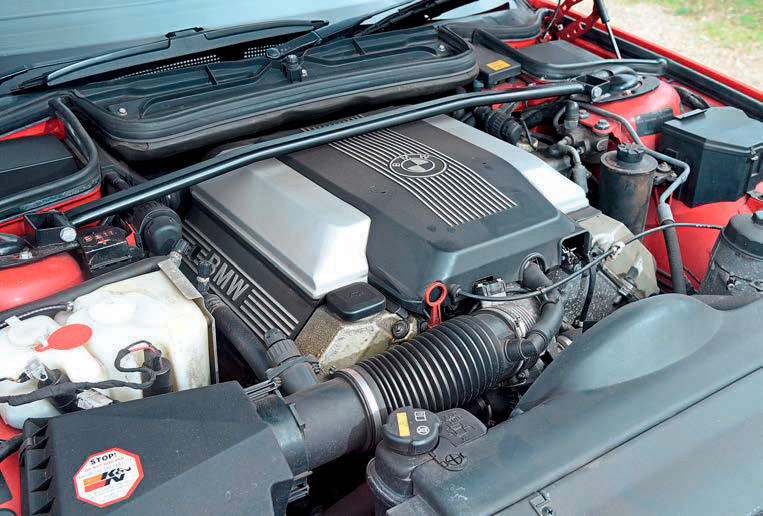
It might be over five decades since the E31’s debut but it remains a big and imposing car, its saloon origins obvious by the way it dwarfs the Aston Martin alongside it. While it could be argued the DB7 is a pastiche of every British sports car before it, the 8-Series was all-new, looking like nothing else before or since with only the famed kidney grilles linking it to the 6-Series and beyond.
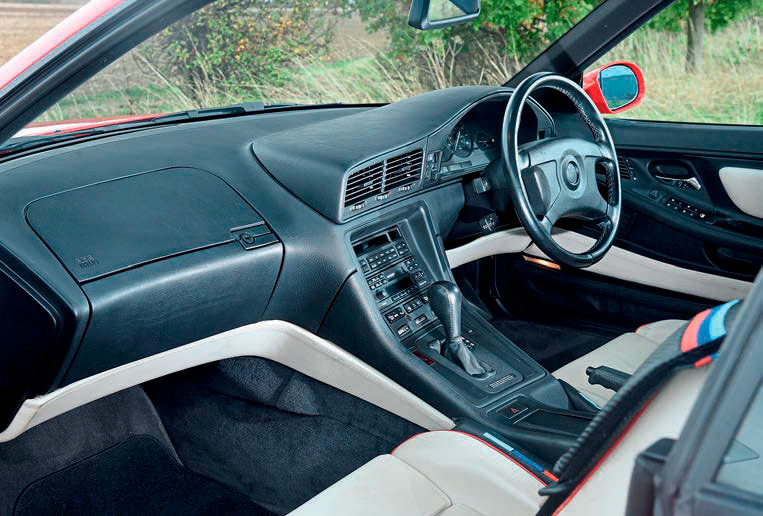
Yet as much I as I appreciate the boldness of the design, it’s too square, too hard and too large for my own tastes; I prefer the soft voluptuousness of the DB7. Those themes continue inside. The 8-Series’ interior is dominated by a wide and hard-edged centre console that in typical BMW efficiency is slightly angled towards the driver. The layout, more than the lack of wood, makes it appear more modern than the Aston’s antiquated design. As Car magazine said in its November 1996 issue about the 8-Series’ interior, “The external squareness of the 840 is echoed inside, by edges and angles that looked very high tech in 1989.”

Made from a particular variety of strong yet soft-to-touch black plastic only found in German cars, the cabin’s ambience is more Braun travel alarm clock than luxury GT but it’s still strongly built, more so I’d argue than the often fragile-feeling Aston. According to the official performance figures, at 6.7 seconds, the BMW is faster to 60mph than the DB7 by a mere 0.1 of a second yet as I squeeze the throttle, thanks to a flatter torque curve with a lower peak, it feels faster than that. A tiny handful of 840Cis were fitted with a six-speed manual transmission while most, like this one, had a five-speed automatic. More eager to kick down than the Aston’s ancient four-speed gearbox, it results in punchier acceleration.
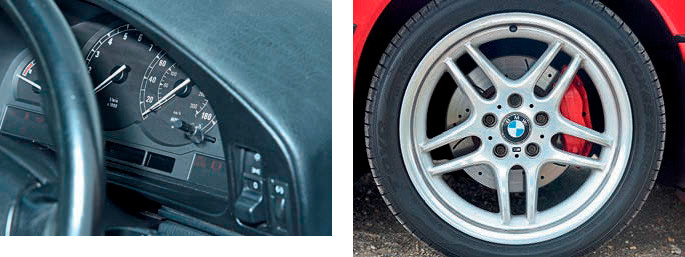
The suspension’s compliancy is more like that of a genuine sports car, such as BMW’s own Z3, resulting in a relatively hard, unforgiving ride. But since the 840Ci E31 weighs 1,855kg – 130kg more than the DB7 coupe – it’s also too big and too heavy, plus it suffers from an abundance of body roll to take corners at high speeds comfortably. Yet for all its faults, the BMW is still a magnificent car; beautifully built and well-engineered, it feels stronger and better put together than the Aston Martin. Is this enough to beat the still popular British GT?
TECHNICAL DATA 1997 BMW 840Ci Auto 4.4 E31
- Engine: 4,389cc V8 BMW M62B44TU
- Max Power: 286bhp
- Max Torque: 310lb ft
- 0-60mph: 5.8secs
- Max speed: 155mph
- Transmission: 5-spd auto
- Weight: 11,855kg
- Price new: £56,850
- Value now: £15,000-£25,000
1997 Aston Martin DB7 Coupe Auto
Peel away the Aston Martin’s beautiful curvaceous body plus the hype that surrounds the famous winged badge on the nose and the car hides a secret; the chassis and suspension are both derived from the Jaguar XJ-S.
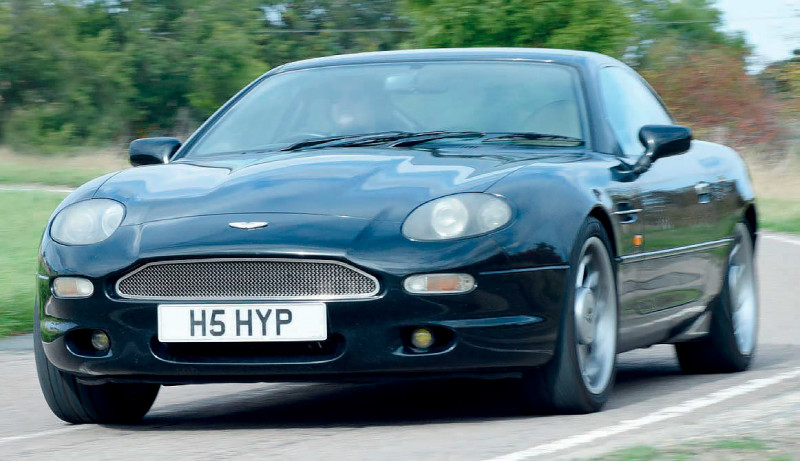
This is because the car we now know as the DB7 started life in the early Eighties as a Jaguar project. The work of one of the company’s designers, Keith Helfet, the XJ40-based car was originally known as the XJ41 and was planned as the eventual replacement for the XJ-S. With Keith unashamedly influenced by Jaguar’s past cars – the E-type especially – his design featured the sort of soft, flowing curves that made the older model so iconic.
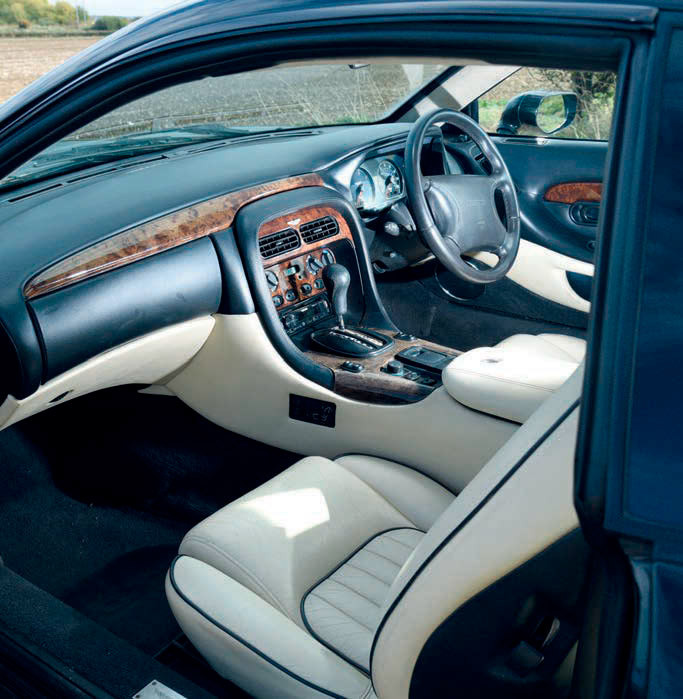
But an ever more complicated specification that included all-wheel drive plus a twin turbo version of Jaguar’s AJ6 engine meant the company’s new owner, Ford, considered the XJ41 too expensive, shelving the project in 1989. Keith later realised that the body would fit the Jaguar XJ-S’ platform meaning the programme could be resurrected for a fraction of the cost. Jaguar’s then engineering director, Jim Randle, showed the idea to Tom Walkinshaw who immediately agreed to put the reborn XJ41 into production. Walkinshaw and his TWR team had been behind the company’s motorsport successes throughout the Eighties and since 1988 had jointly owned a satellite operation, JaguarSport, which made sportier versions of Jaguar’s existing range as well as the XJ220 supercar.
Although at this point still a Jaguar (now known as Project XX), unbeknown to Keith, Jim and everyone else at the company, Walkinshaw later approached Ford suggesting that if the car was badged as an Aston Martin – which the American giant had also bought in 1992 – it could be sold for a higher purchase price. Ford readily agreed and despite production being located at the former JaguarSport facility outside Banbury in Bloxham, the project was renamed NPX for Newport Pagnell Experimental. Walkinshaw then instructed former Ford designer, Ian Callum, to further ‘Astonise’ the design.
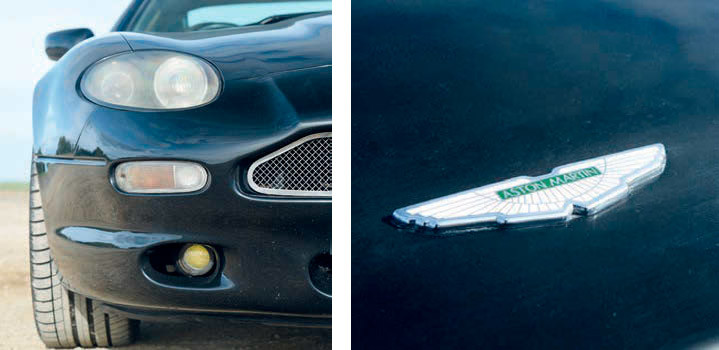
“I did a complete review of the DB7’s predecessors to determine the styling cues that make an Aston an Aston,” said Callum in the June 1993 Automobile magazine. “To get the ‘atmosphere’ right, I focused on the DB4, DB5 and DB6. They are the most successful Astons, visually, and the ones people remember most. They look very purposeful and very elegant. I wanted to design something that has its own personality but evokes their honesty and integrity without being a pastiche.”
The biggest changes Callum made were to pull the screen further forward and add a modern interpretation of the famed Aston Martin radiator grille. According to an interview in Andrew Noakes’ 2006 book, Aston Martin DB7: The Complete Story, Callum spent a lot of time analysing its shape. “It took me ages to get right,” admitted Callum in Noakes’ book. “It’s immensely sensitive.”
Due to Ford demanding production costs to be kept low, Walkinshaw raided the giant company’s ever-growing parts bin that included Mazda, which the American giant had been buying shares in since 1979. The rear lights came from the 323F, the chrome door handles were the same as the 323 estate and the indicators were MX-5. Much of the interior switchgear was sourced from Ford itself while power came courtesy of Jaguar’s 3.2-litre straight-six. Although it first powered the XJ-S during the early Eighties in 3.6 form, with the addition of a supercharger by American firm, Eaton, the engineers still managed to eke out a healthy 335bhp from the now elderly unit.
Strangely, the wing mirrors were the only ‘foreign’ parts, which were Citroën CX. As a result of this upcycling, the NPX project cost a mere $30 million to develop, pocket change for a new car, even at the time.

Yet the penny pinching didn’t stop the DB7 coupe (and the Volante from 1996 onwards) from being incredibly beautiful. More importantly, despite its Jaguar heritage, the car still looked like an Aston Martin when it debuted at the Geneva Motor Show in early 1993. & Motor magazine described the car as having, “a classic sports car look, with a long bonnet, short boot and a hint of gently waisted haunches.”
And five decades later, it still does. Arguably one of the best-looking two-door coupes from the Nineties, it hasn’t aged like others have from the era including the awkwardly angular BMW 8-Series sat next to it.
One aspect of the car that’s always disappointed is the interior. As Autocar said in its October 19 1994 issue, “There’s a lot to find fault with here.” Not so much the layout; aside from the cruise control switches located behind the gearlever of this example, it’s relatively easy to use. What lets it down is the heavy use of Ford switchgear that makes me feel like I’m sitting in an Escort.
And although there’s wood veneer, it’s not an integral part of the dash but simply stuck onto the centre console as it might be in a home-made kit car. If the German car is a travel alarm clock, this makes the DB7 a slightly tacky carriage clock.
But more disappointing than the Ford switchgear or cheap wood is the poor way it has been put together. Feeling weak and fragile, this black DB7 might be the same age as the red BMW but even though it has 18,000 less miles on the clock, the interior hasn’t worn as well. Whereas the 840Ci looks and feels like new, the driver’s seat in the Aston is badly worn plus several areas of the leather trim are starting to come apart. Considering this car cost a whopping £82,500 in 1997, £26k over the 840Ci alongside, it’s disappointing.
Despite having 49bhp more than the BMW, the DB7 doesn’t feel as quick, the throttle pedal needing a proper shove for the supercharger to finally wake up. But with 90 percent of the 360lb ft of torque apparently available between 2,200rpm and 5,500rpm, when it arrives the eventual acceleration has a surprisingly hard edge to it. Yet I still view the official 0-60mph time of just under six seconds as overly generous, especially since the BMW is officially just 0.1 seconds faster. Sounding rough and unrefined, since the engine’s origins go back to the Eighties, even when new the DB7 would have felt old-fashioned.
This example has a four-speed automatic gearbox which, for the Nineties when most other manufacturers were fitting five-speeders, was more oldfashioned than the five-speed bicycle I had when I was a kid. Slow to act and always dim-witted, it takes a colossus effort for it to kick down. The DB7 was also available with five-speed manual transmission, and I know from past experience that this is the one to choose, allowing the engine to come alive more easily.
The suspension follows the same route as the XJ-S which means double wishbones at the front with a lower wishbone at the rear and the driveshafts acting as upper links. Yet, feeling tauter, the DB7 doesn’t ride as beautifully as the car it’s based on and any imperfections can be felt in the cabin. Early DB7s had several panels produced in composite meaning at 1,750kg it was very light, but from July 1996 onwards the bonnet was replaced for a steel version. But at 1,825kg this 1997 example is still 30kg less than the BMW 840Ci E31. With close to 50/50 weight distribution, controlled body roll, accurate steering and plenty of grip, it’s a surprisingly agile machine, more so in my opinion than the larger, heavier and grander 840Ci E31. Although far from perfect, the DB7 is still a hugely likable and characterful car that has the added bonus of being relatively rare with only 2,473 3.2 examples (coupe and Volante) made between 1993 and 1999. Is this enough for it to take on the mighty 8-Series E31?
Regular readers might recognise the black DB7 3.2 featured here as our own, a car I’ve got to know intimately over the last few months. Although I’ve come to appreciate its looks, character and even its many foibles over that time, there’s no denying it can’t hold a candle to the BMW in terms of engineering. Using an old engine and by being based on an even older car, together with being developed on a shoestring in Warwickshire means it wasn’t as well put together as the 8-Series. And 30 years later after the model’s debut, as judged by the poor state of the interior, that’s making itself known more than ever. Although I’m not a fan of the BMW’s bold but slab-sided design or its cold Teutonic efficiency, despite the Aston Martin having slightly better handling, there’s no denying in terms of build quality and performance the 840Ci is the much better car.
The two might have many similarities – including current values at between £15k and £25k – but it’s due to the many significant differences, and not just on paper, that makes the BMW the winner here.
TECHNICAL DATA 1997 Aston Martin DB7 3.2 Auto
- Engine: 3,229cc l6 SC
- Max Power: 335bhp
- Max Torque: 360lb ft
- 0-60mph: 5.7secs
- Max speed: 165mph
- Transmission: 4-spd auto
- Weight: 1,725kg
- Price new: £82,500
- Value now: £15,000-£25,000
Thanks to: Debbie and Paul Blythe, owners of the BMW 840Ci E31 featured in this article
Arguably one of the best looking two-door coupes from the Nineties, it hasn’t aged like others have from the era including the angular BMW 8-Series E31 alongside
THREE’S A CROWD
There was another two-door coupe that made its debut in the mid-Nineties, the Jaguar XK8 X100, which, like the BMW, was fitted with a then-new 4.0-litre V8. By also being initially designed by Keith Helfet – before his colleague, Fergus Pollock, took it through to production – it has resulted in the car that has similar soft lines to the Aston making it, in my eyes, better looking than the more angular BMW. Yet I don’t think the Jaguar is as pretty as the DB7, because the nose is too fussy and the tail not as elegant.
Where it wins over both the Aston and BMW is how it drives; with 290bhp, the 4.0 V8 might have 45bhp less than the Aston’s supercharged straight-six, but by being free revving and eager it accelerates just as keenly as the BMW, the five-speed gearbox needing little persuasion to drop down a gear or two, resulting in a sudden and hard acceleration. Although at 6.6 seconds to reach 60mph, it’s not as sharp as the BMW’s, but the Jaguar’s V8 is still a masterful engine. Smooth, refined, yet with a subtle but distinctive growl, there’s little wonder it became the mainstay of Jaguar’s cars in one form or another for the next decade until replaced by the largely all-new 5.0-litre.
Despite being steel-bodied, at 1,649kg the XK8 is the lightest of the three and with sharp and accurate steering feels much nimbler through corners than the heavyweight German. Its ride is also better than the Aston’s, having more of that supple compliance Jaguar is famous for.
With over 90k examples produced between 1996 and 2005, the mass-produced X100 XK8 doesn’t have rarity on its side like the other two. But by starting at just £5k for a 4.0-litre coupe such as the 2000 example pictured here, it’s, one we’d choose over both the BMW 840Ci E31 and Aston Martin DB7.
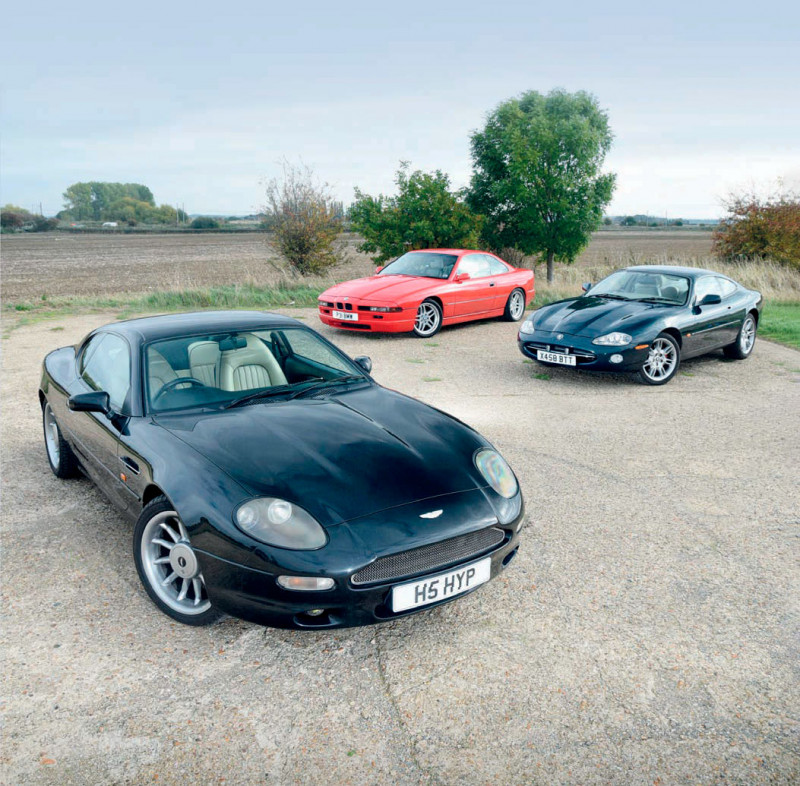


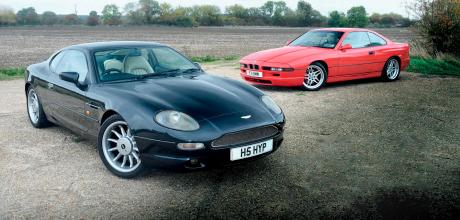
Aston DB7 vs Mondial vs 911 996